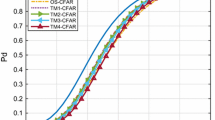Abstract:
We observed sea clutter using a millimeter wave radar having a frequency 34.86GHz, a beamwidth 0.25°, and a pulsewidth 30ns. To determine the sea clutter amplitude, we introduce the Minimum Description Length (MDL) principle, which is more rigorous fit of the distribution to the data than the Akaike Information Criterion (AIC). It is discovered that the sea clutter amplitudes obey the log-Weibull distribution with the shape parameter of 19.19 for entire data and the Weibull and log-Weibull distributions with the shape parameters of 4.81 to 5.17 and 17.72 to 20.99, respectively, for data within the beam width of an antenna.
Similar content being viewed by others
References
[1] Currie, N. C. and Brown, C. E., ed. : “Principles and Applications of Millimeter-Wave Radar”, Artech House, Norwood, 1987.
[2] Sekine, M. and Mao, Y. H. : “Weibull radar clutter”, London, Peter Peregrinus Ltd., 1990.
[3] Sayama, S. and Sekine, M. : “Suppression of sea-ice clutter observed by a millimeter wave radar using a new log-Weibull/CFAR System”, International Journal of Infrared and Millimeter Waves, 2004, pp.1481–1494.
[4] Rissanen, J. : “Modeling by shortest data description”, Automatica, 1978, pp.465–471.
[5] Akaike, H. : “Information theory and an extension of the maximum likelihood principle”, In B. N. Petrov and F. Csaki (Eds.), 2nd International Symposium on Information Theory, Akademiai Kiado, Budapest, 1973, pp.267–281.
[6] W. Weibull : “Statistical theory of strength of materials”, IVB-Handl., 1939.
[7] Sekine, M., Musha, T., Tomita, Y., Hagisawa, T., Irabu, T., and Kiuchi, E.: “Log-Weibull distributed sea clutter”, IEE Proceedings, 1980, Pt. F, pp.225–228.
[8] Sayama, S. and Sekine, M. : “Weibull, log-Weibull and K-distributed ground clutter modeling analyzed by AIC”, IEEE Transactions on Aerospace and Electronic Systems, 2001, pp.1108–1113.
[9] Sakamoto, Y., Ishiguro, M., and Kitagawa, G. : Information Statistics, Kyoritsu Shuppan Co., Ltd., Tokyo, Japan, 1983, (in Japanese).
[10] Han, T. S. and Kobayashi, K. : “Mathematics of Information and Coding”, Baifukan Co., Ltd, Tokyo, Japan, 1999, (in Japanese).
[11] Yamanishi, K. and Han, T. S. : “Introduction to MDL from Viewpoints of Information Theory”, Journal of Japanese Society for Artificial Intelligence, 1992, pp.427–434, (in Japanese).
Author information
Authors and Affiliations
Rights and permissions
About this article
Cite this article
Sayama, S., Ishii, S. & Sekine, M. Amplitude Statistics of Sea Clutter Observed by a Millimeter Wave Radar Analyzed by Minimum Description Length (MDL) Principle. Int J Infrared Milli Waves 26, 1639–1649 (2005). https://doi.org/10.1007/s10762-005-0037-5
Received:
Published:
Issue Date:
DOI: https://doi.org/10.1007/s10762-005-0037-5




